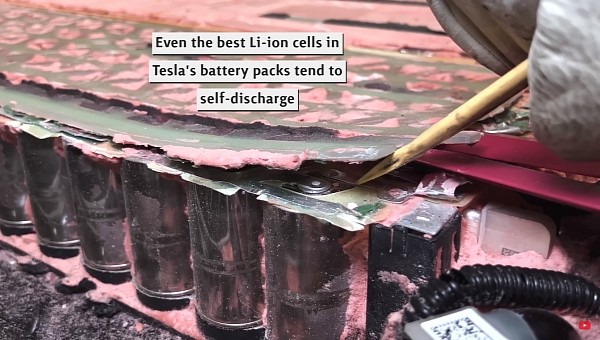Researchers at a Tesla-funded battery research facility in Halifax, Canada, have discovered by chance what’s causing Li-ion batteries to self-discharge. Thanks to their discovery, a very simple solution is now being worked out, improving Li-ion battery’s lifecycle for all of us.
Li-ion batteries tend to self-discharge even when not in use. This was well-known and documented, although nobody bothered to find out what was causing it. Thankfully, the researchers at Dalhousie University in Canada looked into it and found the surprising culprit was a very common material used in every Li-Ion battery. Specifically, it’s a plastic tape normally used in commercial batteries to hold the electrodes together. Like regular Scotch tapes, this plastic film decomposes, creating the molecules that lead to self-discharge.
The researchers opened several cells during their study after exposing them to different temperatures. They were surprised that the electrolyte solution inside the cells was bright red, so they began exploring the cause. The researchers placed the cells into ovens at three different temperatures. The one at 25 degrees Celsius (77 degrees Fahrenheit) remained clear, while the sample at 55 C (131 F) was colored light brown. Finally, the hottest one was put at 70 C (158 F), which caused it to turn bright red.
When they did a chemical analysis of the electrolyte, the team discovered that the polyethylene terephthalate (PET) in the tape decomposed and created the molecules that led to the self-discharge. Because the molecules can travel between electrodes, just like Lithium ions do, it is called a redox shuttle. That’s what’s causing the discharge, thanks to this continuous movement of the redox shuttle molecules in the background.
“It’s something we never expected because no one looks at these inactive components, these tapes and plastic foils in the battery cells, but it really needs to be considered if you want to limit side reactions in the battery cell,” said Michael Metzger, an assistant professor at Dalhousie University and one of the study’s authors.
However simple, the discovery is critically important for battery manufacturers seeking to improve their products. The study can lead to an easy fix involving replacing the PET tape with a more stable material that won’t degrade. Thus, the Li-Ion batteries will keep the charge when not in use for extended periods, a boon for both electric vehicles and consumer electronics.
Dalhousie University is known for its team of scientists led by Jeff Dahn, a pioneer in lithium-ion battery development. Dahn started working on Li-ion batteries in the late 1970s and, in 2015, signed a research partnership with Tesla that is still ongoing. The connection between Tesla and Dalhousie University goes deeper, though, as Tesla established a battery research lab in Halifax to cement its relationship with Dalhousie. Since 2016, Tesla has funded several battery research works at Dalhousie. At least six of Tesla’s patent applications related to batteries list Dahn and members of his team as co-inventors.
The researchers opened several cells during their study after exposing them to different temperatures. They were surprised that the electrolyte solution inside the cells was bright red, so they began exploring the cause. The researchers placed the cells into ovens at three different temperatures. The one at 25 degrees Celsius (77 degrees Fahrenheit) remained clear, while the sample at 55 C (131 F) was colored light brown. Finally, the hottest one was put at 70 C (158 F), which caused it to turn bright red.
When they did a chemical analysis of the electrolyte, the team discovered that the polyethylene terephthalate (PET) in the tape decomposed and created the molecules that led to the self-discharge. Because the molecules can travel between electrodes, just like Lithium ions do, it is called a redox shuttle. That’s what’s causing the discharge, thanks to this continuous movement of the redox shuttle molecules in the background.
“It’s something we never expected because no one looks at these inactive components, these tapes and plastic foils in the battery cells, but it really needs to be considered if you want to limit side reactions in the battery cell,” said Michael Metzger, an assistant professor at Dalhousie University and one of the study’s authors.
However simple, the discovery is critically important for battery manufacturers seeking to improve their products. The study can lead to an easy fix involving replacing the PET tape with a more stable material that won’t degrade. Thus, the Li-Ion batteries will keep the charge when not in use for extended periods, a boon for both electric vehicles and consumer electronics.
Dalhousie University is known for its team of scientists led by Jeff Dahn, a pioneer in lithium-ion battery development. Dahn started working on Li-ion batteries in the late 1970s and, in 2015, signed a research partnership with Tesla that is still ongoing. The connection between Tesla and Dalhousie University goes deeper, though, as Tesla established a battery research lab in Halifax to cement its relationship with Dalhousie. Since 2016, Tesla has funded several battery research works at Dalhousie. At least six of Tesla’s patent applications related to batteries list Dahn and members of his team as co-inventors.







